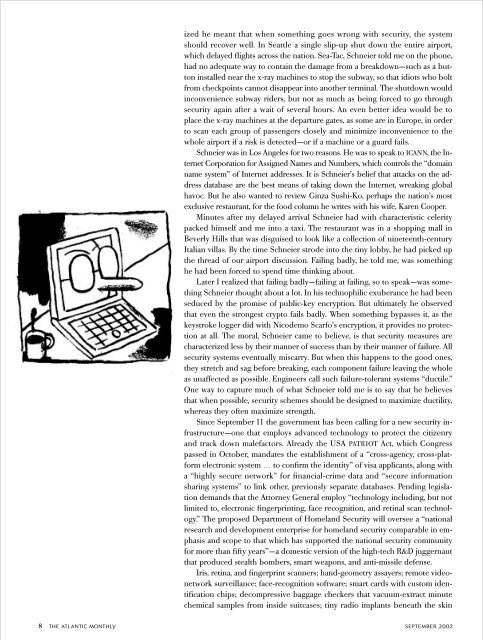HOMELAND INSECURITY - Charles C. Mann
HOMELAND INSECURITY - Charles C. Mann
HOMELAND INSECURITY - Charles C. Mann
Create successful ePaper yourself
Turn your PDF publications into a flip-book with our unique Google optimized e-Paper software.
Sept-Insecurity.pages 6/28/02 10:37 AM Page 8<br />
ized he meant that when something goes wrong with security, the system<br />
should recover well. In Seattle a single slip-up shut down the entire airport,<br />
which delayed flights across the nation. Sea-Tac, Schneier told me on the phone,<br />
had no adequate way to contain the damage from a breakdown—such as a button<br />
installed near the x-ray machines to stop the subway, so that idiots who bolt<br />
from checkpoints cannot disappear into another terminal. The shutdown would<br />
inconvenience subway riders, but not as much as being forced to go through<br />
security again after a wait of several hours. An even better idea would be to<br />
place the x-ray machines at the departure gates, as some are in Europe, in order<br />
to scan each group of passengers closely and minimize inconvenience to the<br />
whole airport if a risk is detected—or if a machine or a guard fails.<br />
Schneier was in Los Angeles for two reasons. He was to speak to ICANN, the Internet<br />
Corporation for Assigned Names and Numbers, which controls the “domain<br />
name system” of Internet addresses. It is Schneier’s belief that attacks on the address<br />
database are the best means of taking down the Internet, wreaking global<br />
havoc. But he also wanted to review Ginza Sushi-Ko, perhaps the nation’s most<br />
exclusive restaurant, for the food column he writes with his wife, Karen Cooper.<br />
Minutes after my delayed arrival Schneier had with characteristic celerity<br />
packed himself and me into a taxi. The restaurant was in a shopping mall in<br />
Beverly Hills that was disguised to look like a collection of nineteenth-century<br />
Italian villas. By the time Schneier strode into the tiny lobby, he had picked up<br />
the thread of our airport discussion. Failing badly, he told me, was something<br />
he had been forced to spend time thinking about.<br />
Later I realized that failing badly—failing at failing, so to speak—was something<br />
Schneier thought about a lot. In his technophilic exuberance he had been<br />
seduced by the promise of public-key encryption. But ultimately he observed<br />
that even the strongest crypto fails badly. When something bypasses it, as the<br />
keystroke logger did with Nicodemo Scarfo’s encryption, it provides no protection<br />
at all. The moral, Schneier came to believe, is that security measures are<br />
characterized less by their manner of success than by their manner of failure. All<br />
security systems eventually miscarry. But when this happens to the good ones,<br />
they stretch and sag before breaking, each component failure leaving the whole<br />
as unaffected as possible. Engineers call such failure-tolerant systems “ductile.”<br />
One way to capture much of what Schneier told me is to say that he believes<br />
that when possible, security schemes should be designed to maximize ductility,<br />
whereas they often maximize strength.<br />
Since September 11 the government has been calling for a new security infrastructure—one<br />
that employs advanced technology to protect the citizenry<br />
and track down malefactors. Already the USA PATRIOT Act, which Congress<br />
passed in October, mandates the establishment of a “cross-agency, cross-platform<br />
electronic system … to confirm the identity” of visa applicants, along with<br />
a “highly secure network” for financial-crime data and “secure information<br />
sharing systems” to link other, previously separate databases. Pending legislation<br />
demands that the Attorney General employ “technology including, but not<br />
limited to, electronic fingerprinting, face recognition, and retinal scan technology.”<br />
The proposed Department of Homeland Security will oversee a “national<br />
research and development enterprise for homeland security comparable in emphasis<br />
and scope to that which has supported the national security community<br />
for more than fifty years”—a domestic version of the high-tech R&D juggernaut<br />
that produced stealth bombers, smart weapons, and anti-missile defense.<br />
Iris, retina, and fingerprint scanners; hand-geometry assayers; remote videonetwork<br />
surveillance; face-recognition software; smart cards with custom identification<br />
chips; decompressive baggage checkers that vacuum-extract minute<br />
chemical samples from inside suitcases; tiny radio implants beneath the skin<br />
8 THE ATLANTIC MONTHLY SEPTEMBER 2002




